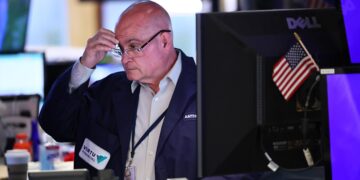The Dow Jones Industrial Average (^DJI) gained roughly 200 points, rising 0.4%, while the S&P 500 (^GSPC) also edged up 0.4%, inching closer to its first record close since February. The Nasdaq Composite (^IXIC) added about 0.3% as major tech names, including Nvidia (NVDA), continued their upward momentum. Nvidia was marginally higher after hitting a record high on Wednesday.
Why are investors reacting to Trump’s plans for the Fed chair?
President Trump’s dissatisfaction with Jerome Powell’s “wait and see” stance on interest rates is pushing him to potentially announce a new Fed chair nominee by September or October, according to The Wall Street Journal. This development has rattled monetary policy watchers and traders, who now view it as a sign that rate cuts may come sooner than expected.
If Trump does name a successor, Powell’s influence could weaken well before his term ends in May 2026, and markets may start focusing on the next chair’s likely policy path. Trump has been vocal about wanting lower interest rates to support economic growth and counteract the drag from tariffs and debt risks.
What are the latest stock market numbers today?
Here’s how major indexes performed Thursday:
- Dow Jones Industrial Average: +0.4%, up about 200 points
- S&P 500: +0.4%, nearing a new record high not seen since February
- Nasdaq Composite: +0.3%
- Nvidia (NVDA): Slight gain, extending its all-time high streak
The overall tone was optimistic across Wall Street as traders grew more confident that Trump’s direction could lean toward monetary easing.
How is the US dollar and Treasury yield reacting?
The US dollar index (DX=F) dropped to its lowest level since April 2022, reflecting rising expectations of looser monetary policy. A weaker dollar typically boosts US exports and corporate earnings but also signals caution over tariff impacts and default risks. At the same time, Treasury yields pulled back, with the 10-year yield (^TNX) trading around 4.26%, down from earlier levels. Investors seem to be factoring in a higher probability of cuts in borrowing costs, which tend to lower bond yields and make stocks more attractive.
What’s happening with the US economy and jobs data?
Fresh data from Thursday showed the US economy shrank by 0.5% in the first quarter, according to the government’s final estimate—worse than the previous reading. This contraction is adding to concerns about underlying economic weakness.
At the same time, jobless claims rose, with continuing claims climbing to their highest level since late 2021, suggesting some softness in the labor market. These numbers are likely to further bolster the argument for the Fed—or a new chair appointed by Trump—to consider rate cuts in the near term.
📈 Dow Jones Industrial Average
- Rose ~231 points (+0.5%) during Thursday trading, with Boeing and Goldman Sachs climbing ~1.6% and 1.5% respectively—adding around 79 points to the index
- Closing just below its recent record, the Dow continues to lead amid strong corporate earnings.
📊 S&P 500
- The S&P 500 had its smallest daily move in eight years, sliding just 0.0003% on Wednesday
- It remains less than 1% below its all-time high, with markets calm despite geopolitical tensions
🚀 Nasdaq Composite
- The Nasdaq climbed about 0.4%, driven by Nvidia’s 0.5% gain and a strong session for chipmakers like Micron following positive earnings
- Nvidia maintains its spot as the world’s most valuable company.
What are investors watching for in the PCE inflation report?
The big market-moving event to end the week comes Friday with the release of the Personal Consumption Expenditures (PCE) inflation report, the Fed’s preferred inflation gauge. Investors will closely examine whether Trump’s tariff policies have begun to impact consumer prices.
If the report shows a meaningful uptick in inflation, it could complicate Trump’s push for interest rate cuts. On the other hand, tame inflation could pave the way for a more dovish Fed—or the next Fed chair—to act sooner.
What does this mean for rate cuts and market momentum?
Between Trump’s expected Fed chair announcement, weaker economic growth, rising jobless claims, and a falling dollar, the setup for a potential shift toward rate cuts is building. Traders are increasingly betting that the Fed could pivot, especially if the PCE data supports the argument for easing.
Markets will remain highly sensitive to any hints from Trump or the Fed in the coming days, as investors try to price in the likely path for interest rates in the second half of 2025.
FAQs:
Q1: Why did US stocks rise today?
Stocks rose on hopes of interest rate cuts after Trump hinted at replacing Fed Chair Powell.
Q2: What could Trump’s Fed decision mean for inflation?
It may increase chances of rate cuts, but Friday’s PCE data will reveal if tariffs raised prices.





















